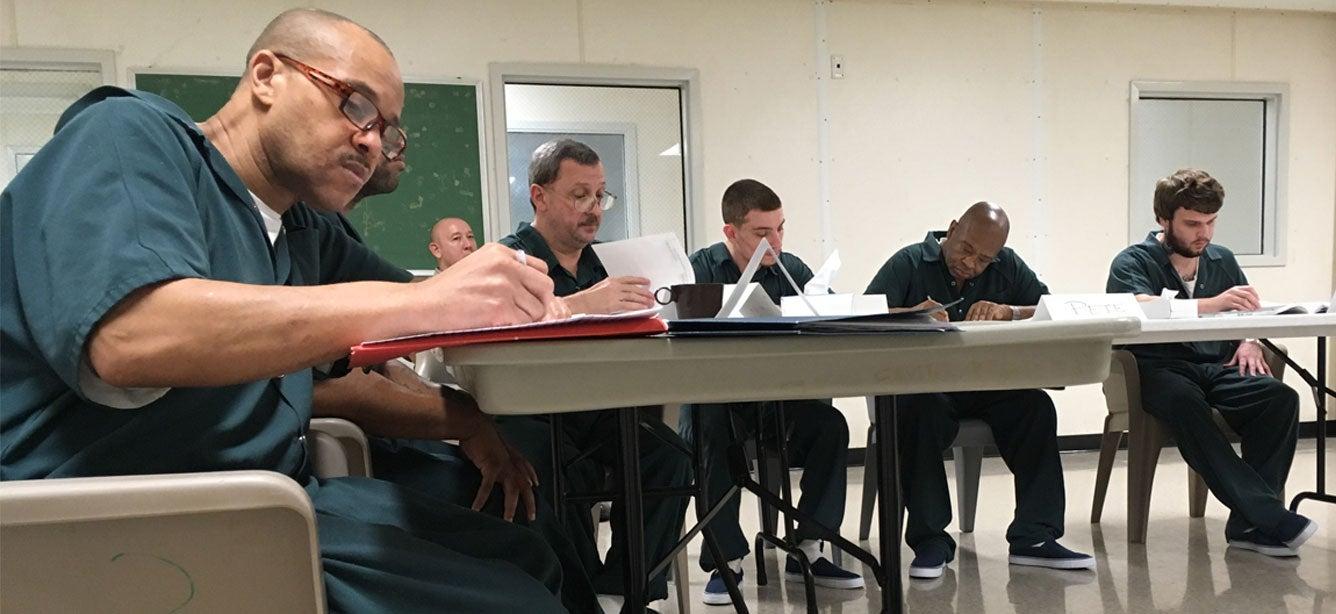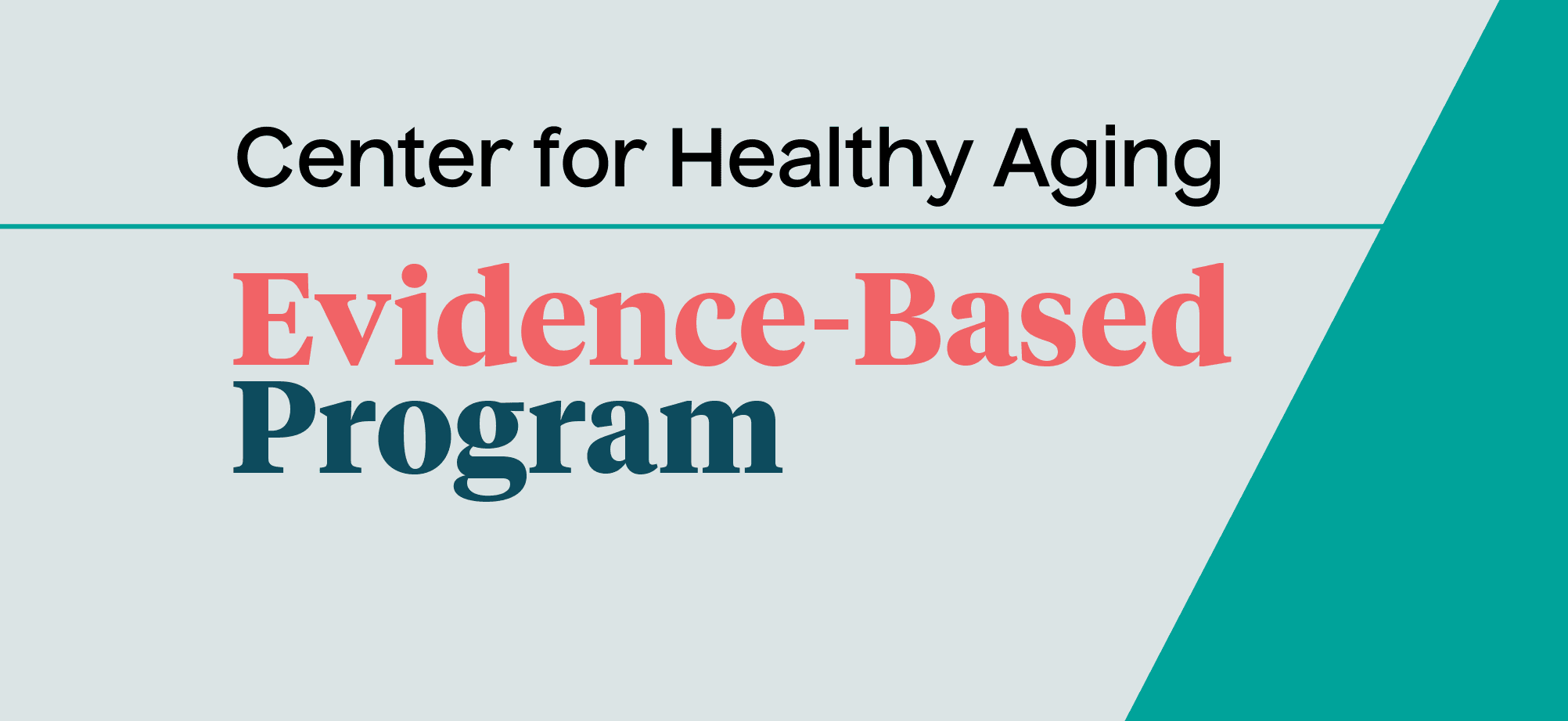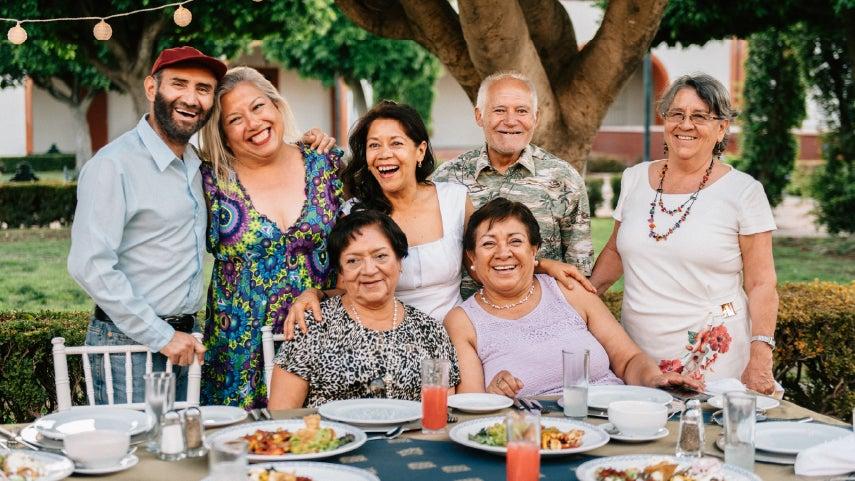Tip Sheet: Partnering with Correctional Facilities to Implement Evidence-Based Health Promotion Programs
18 min read

America’s prison population is aging rapidly. According to the National Association of Area Agencies on Aging’s report, Supporting America’s Aging Prisoner Population: Opportunities & Challenges for Area Agencies on Aging, the number of state and federal prisoners age 65+ grew at a rate 94 times the overall prison population between 2007 and 2010. This increase can be attributed to a variety of factors including the aging of the overall U.S. population, longer prison terms due to factors such as mandatory minimum sentencing, and an increase in the number of older people committing crimes. As a result, the criminal justice system now houses an older population, many of whom need assistance with every day activities, including bathing, dressing, and eating.1 At least 50 percent of older prisoners need access to nursing care for at least 16 hours per day.2
Several factors contribute to evidence that individuals living in correctional facilities age more quickly than those living in the community, including reduced access to high quality health care, difficulty adhering to medication regimes, high rates of behavioral health issues, and current or past substance abuse.1 These factors contribute to the approximate 73 percent of prisoners aged 50+ that have at least one chronic health condition.1 Furthermore, the physical living conditions in correctional facilities, like poor lighting, uneven flooring, use of bunk beds, and lack of handrails, increase older prisoners’ risk of falls and injuries.2 A high rate of ongoing health conditions and safety risks contribute to health care costs for older prisoners that are three to nine times higher than the general population.2
The Value of Evidence-Based Programs
Evidence-based health promotion programs focused on topics including chronic disease self-management, falls prevention, physical activity, behavioral health, and nutrition can help older inmates address some of the unique health challenges of living in a correctional facility and prepare them to transition back to the community following release.
For example, a national study of the Chronic Disease Self-Management Program (CDSMP) found improvements in self-reported health including feeling healthier, engaging in more physical activity, fewer days in depression, fewer sick days, and an overall better quality of life. The program also improved participant’s communication with physicians, medication compliance, and confidence in completing medical forms. Among the general population, participation in the program reduced emergency room and hospital utilization, with a net savings of $364 per person.3
Furthermore, the implementation of evidence-based falls prevention programs are one way to address the high cost of injuries due to falls, which totaled $31 billion in 2015 among the general population.4 The two most common programs include A Matter of Balance and Stepping On, among many others. A Matter of Balance has been found to reduce participant’s fear of falling and increase plans to continue regular exercise, for a net savings to Medicare of $938 in unplanned medical expenses per participant. Research on Stepping On has shown a 30% reduction in the rate of falls among participants, for a 64% return on investment of $134 net savings per participant.5
“[The Chronic Disease Self-Management Program] helps offenders with chronic conditions take charge of their own well-being, contributing to better health outcomes while they’re incarcerated and successful re-entry into their communities when they’re released.”
– Harold Clarke, Director, Virginia Department of Corrections 6
Strategies for Collaborating with Correctional Facilities
Identify Program Champions and Build A Partnership
State and community-based organizations that are implementing evidence-based programs may reach out to the state or county department of corrections or an individual prison, jail, transitional program, or correctional health care organization to explore opportunities for collaboration. As with any new relationship, it’s critical to identify staff “champions” that will advocate for the implementation of these programs. Be prepared to orient new staff members to the structure and value of evidence-based programs, as wardens and other key staff may change over time. Through initial meetings, it’s important to learn more about facility approval processes or guidelines for program implementation. It can also be beneficial to establish a memorandum of understanding or other written agreement to clarify the roles and responsibilities of the state or community-based organization and the correctional facility.
Program Leadership and Implementation
Program implementation in correctional facilities may require special planning. Collaborate with correctional facility staff to:
- Discuss which evidence-based programs are most needed and appropriate for the correctional facility. If available, consider whether in-person, mailed, or online CDSMP is preferable.
- Determine whether participants are allowed access to program materials, such as books, CDs, or writing utensils. If not, what are the alternatives to provide this information to participants or to complete written forms?
- Coordinate with the administration and security officers to ensure participants are available to attend each program session.
- Find a space to hold the program that is large enough to comfortably accommodate a group of 10-15 participants. It’s important to have the option of sitting in a circle to ensure all participants feel included in group discussions. Some organizations have reported that program participants in correctional facilities were concerned about sitting too close to each other.
- Expect and address any issues that affect the correctional facility’s capacity to partner to implement evidence-based programs, including increased responsibility for correctional staff or statewide furloughs.
Work with trained evidence-based program leaders on the following issues:
- Instruct leaders on what steps are required to enter the facility, including completing a background check or following certain security protocols.
- Plan to conduct Session Zero, an orientation session that demonstrates the topics to be covered in the program and ensures that potential participants have a clear understanding of whether or not they would like to participate.
- Train program leaders to explain and collect informed consent (either written or verbal) when administering data collection forms. Leaders should recognize that participants may be concerned about completing forms and have the right to abstain.
- Address any concerns from program participants about correctional staff involvement during the sessions. Staff involvement may negatively affect participation.
- Some states have trained former or current prisoners to serve as program leaders. If prisoners are trained as program leaders, be aware that they may depart the correctional facility due to early parole or release dates causing an interruption in programs until additional leaders are trained.
- Educate program leaders about their role and responsibilities while conducting workshops in correctional facilities, as well as unique circumstances for individuals participating in programs in a correctional or transitional setting. Leaders should be prepared to help the participants use the tools they learn, like action planning or problem solving, in a setting where participants have limited control over what they eat, their schedule, or access to different resources. One organization shared an example of a participant who was unable to obtain his medication before breakfast because he was required to drop off his laundry at a specific time. The participant was frustrated because he was unable to change his laundry drop-off time and the group was unable to brainstorm a suggestion to solve the problem. The leader of this workshop shared, “it is humbling to know just how big some of the small problems are.”
Data Collection and Participant Protection
It is important for community-based organizations implementing evidence-based programs with prisoners to have discussions with the leadership of correctional facilities about data collection and management in order to adequately protect this vulnerable population. During these discussions, consider asking the following questions about the need to take additional precautions to protect or manage data collected from incarcerated participants:
- Are there any questions that need to be removed from the participant questionnaire (e.g. mental health, date of birth)?
- How will participants be identified in attendance logs, and pre- and post-surveys (e.g. partial first/last names and year of birth, prison ID #, or other)?
- Are there particular data fields that should be modified to better reflect prison life (e.g. made home modifications following falls prevention program to reduce falls)?
- What health-related data does the correctional facility already collect from prisoners? Which of this data will be shared with program leaders to help recruit participants?
- Does the prison have specific requirements or policies for protecting prisoner data that may extend to data collected from workshop participants? For example, should workshop data be integrated with prisoner data and kept at the prison as part of their records?
- Does it need to follow HIPAA specifications or meet other criteria?
- Is verbal informed consent sufficient prior to completion of the participant questionnaire? If not, does the correctional facility require that participants complete a written informed consent form?
- Under what circumstances is it required to obtain approval for data collection from an external Institutional Review Board?
- Will participants be permitted to use a pen or pencil to complete the participant questionnaire?
- If the program leader is also a prisoner, must they sign a non-disclosure agreement, given that they will be privy to participant data?
- Is there a location where completed surveys can be locked in a filing cabinet in a secure office, in case the program leaders or coordinators are unable to take the files off-site immediately?
Successful Practices
NCOA's Center for Healthy Aging compiled the following practices from organizations that have been successful in partnering with correctional facilities to implement evidence-based programs, primarily CDSME.
Kentucky
In Kentucky the Department for Aging and Independent Living shared that the key to beginning the partnership was finding a champion inside the prison system. That began as so many things do, with a friend of a friend. The CDSMP grant award was being discussed at a meeting, including the success other states have had in the prison system. A person at the meeting had a friend who worked at the federal medical prison who promoted the concept of teaching prisoners how to better manage their chronic health conditions.
The inmates ranged the full spectrum of convictions but almost all had a medical condition that required them being housed at that particular location. The unit manager recruited the first set of participants and the class was capped at 20 men. The participants were convicted on a variety of crimes and while the leaders did not formally know what the charges were, many of them made mention of their crimes during the classes. The leaders found it best not to know what crimes had been committed, as they did not want the information to affect how they interacted with the class participants.
Based on the success at this federal prison, the Kentucky grantee reached out to another federal prison and began classes there. This setting is known as a “work camp” and houses prisoners convicted on lesser crimes but similar outcomes were found. Leaders reported great attendance and a high level of appreciation from the prisoners for the program.
Virginia
The Virginia Department of Aging and Rehabilitative Services has partnered with the Virginia Department of Corrections (DOC) to foster relationships between area agencies on aging and six prisons across the state. A 2011 analysis conducted by the Virginia DOC reported that older adults were the fastest growing segment of the prison population and that many prisoners were beginning their sentences with more acute medical needs than previously recorded. The Virginia DOC also noted a 19% increase in off-site health care costs from FY 2010 to FY 2011,7 sparking a need for interventions like CDSME. CDSME coordinators and participants shared that the workshops empowered prisoners to take control of healthy behaviors, create supportive relationships with each other, and build problem-solving skills critical to re-entry into the community. As of early 2017, over 40 CDSME workshops have been held in correctional facilities and over 430 prisoners have completed the program.
New Jersey
The New Jersey Department of Human Services (NJ DHS) recognized that the relationship between the prison system and the broader community places correctional health care at the forefront of many of their most pressing public health challenges.8 One central issue is that state prisons release most prisoners to the community, about half of whom return to urban centers. In order to better prepare prisoners for release, the NJ DHS implemented CDSME in state prisons through a grant with University Correctional Health Care where three master trainers trained leaders in 13 state prisons. The mutual support of the participants, facilitators, providers, and the site administration are cited as keys to its success. Prison program evaluations report that prisoners feel a greater sense of control over some aspects of their lives as a result of participating in the program.1
Oklahoma
In Oklahoma, the Department of Corrections recognized CDSME as an official program with its initial training involving correctional facility staff and prisoners to be leaders. Prisoners who participated in CDSME were eligible to receive “achievement credits,” available for participation in specific facility-approved programs. Credits could be used to help decrease the length of individual’s sentences, with ten days of “good time” awarded to offenders who completed all sessions.
Oregon
The Oregon Health Authority, Public Health Division, developed a successful CDSME program delivery partnership with the Department of Corrections, which resulted in dramatically increasing reach to this population that faces a tremendously elevated burden of chronic disease. Referral systems were developed in partnership with nine correctional facilities and a total of 690 prisoners participated in the programs, between 2012-2015. The Oregon Health Authority provided free books for the workshops and the DOC granted permission for the Oregon Health Authority to collect demographic data from participants.
Georgia
The Georgia Division of Aging Services was invited to pilot a CDSMP workshop with residents at a federal transition center, in partnership with the Urban League of Greater Atlanta which had received a grant to implement multiple programs within federal and state transition centers in the Atlanta Metro region. Other partners were the Department of Corrections, and Governor’s Re-entry Task Force. 75% of the original participants completed the six-week workshop. Of those who did not complete, one was granted early release and one obtained full-time employment.
Mississippi
The Mississippi State Department of Health is working with Centurion, a managed care organization that provides health care for the Department of Corrections, and the Mississippi Department of Corrections to identify the appropriate staff to train as CDSMP/DSMP leaders to implement CDSME as part of the prisoner discharge program.
Illinois
AgeOptions in Illinois developed a partnership with the Illinois Department of Corrections, who agreed to pilot CDSME in two of their women’s prisons, with the potential to expand to three additional facilities in the future.
“While the [Chronic Disease Self-Management Program] was not mandatory, we had some of the highest completer rates from the prison groups. In addition, they were the most appreciative participants of all the classes in all the settings that I have taught.” – Marnie Mountjoy, CDSME Program Leader, Kentucky Department for Aging and Independent Living
Testimonials
- In the prison it is easy for inmates to feel as though they are limited in opportunities, good health care, and just forgotten about. This class reinforces to them that although certain rights have been stripped from them, there are some things that they are able to take control of, and that is their health and how they are managing that. One gentleman recognized that at each meal they were getting two slices of bread and after the lesson on portion control and healthy eating, he decided to start trading his bread with other inmates, for extra vegetables. – Savannah Butler, CDSMP/Wellness Coordinator, Senior Connections
- Thank you for the time you have devoted to me. You have created an environment conductive to learning and it has been a great pleasure of mine to have been mentored by you all. The lessons you all have taught me will last a lifetime. No matter my mood, I always left your class in great spirits. And if you never considered what it means to a man in prison to be able to smile, I hope you’ll take a moment to think about it, and then smile yourself. Keep up the good work and don’t change a thing. – Participant, Bland Correctional Center, Virginia.
- What I’ve learned from this class is to have an open mind and to think positive when dealing with my chronic disease. Life isn’t over when you have a disease you have to learn how to manage your chronic condition and move on in life. This book helps you learn how to deal with just about all health problems. I hope you continue to come back so other inmates can have the same knowledge I have received. Thank you so very much for dealing with me these last 6 weeks. I am truly grateful and will always have you in my prayers. – Participant, Bland Correctional Center, Virginia
- It is nice to be treated as a human being and not as an animal or monster. Not a lot to look forward to, but taking the class is the best part of my week. I don’t feel so stressed out after our meeting. The laughter and sharing really makes me feel better. There at the start of my bid (starting my time) I felt alone, but the class made me feel like someone cared about what I was going through, thank you for that. I hope every day finds you joy. – Participant, Bland Correctional Center, Virginia’
Sources
1. National Association of Area Agencies on Aging. Supporting America’s Aging Prisoner Population: Opportunities & Challenges for Area Agencies on Aging. Found on the internet at https://www.n4a.org/Files/n4a_AgingPrisoners_23Feb2017REV%20(2).pdf
2. Human Rights Watch. Old Behind Bars: The Aging Prison Population in the United States. Found on the internet at https://www.hrw.org/report/2012/01/27/old-behind-bars/aging-prison-population-united-states#
3. Ahn S, Basu R, Smith ML, Jiang L, Lorig K, Whitelaw N, Ory MG. The Impact of Chronic Disease Self-Management Programs: Healthcare Savings through a Community-Based Intervention. BMC Public Health, 2013, 13(1):1141.
4. Centers for Disease Control and Prevention. Costs of Falls Among Older Adults. Accessed May 8, 2017. Found on the internet at https://www.cdc.gov/homeandrecreationalsafety/falls/fallcost.html
5. National Council on Aging. Evidence-Based Falls Prevention Programs: Saving Lives, Saving Money. Accessed April 21, 2017.
6. Virginia Department for Aging and Rehabilitative Services. Virginia: Fact Sheet on CDSME in Correctional Facilities.
7. Virginia Department for Aging and Rehabilitative Services. An Examination of Inmate Health Care Costs Virginia Office of Health Services.
8. University of Medicine and Dentistry of New Jersey, University Correctional Health Care. Taking Control of Your Health in the New Jersey Prison System Presented.
This project was supported, in part by grant number 90CR2001-01-00 from the U.S. Administration for Community Living, Department of Health and Human Services, Washington, D.C. 20201. Grantees undertaking projects under government sponsorship are encouraged to express freely their findings and conclusions. Points of view or opinions do not, therefore, necessarily represent official Administration for Community Living policy.



